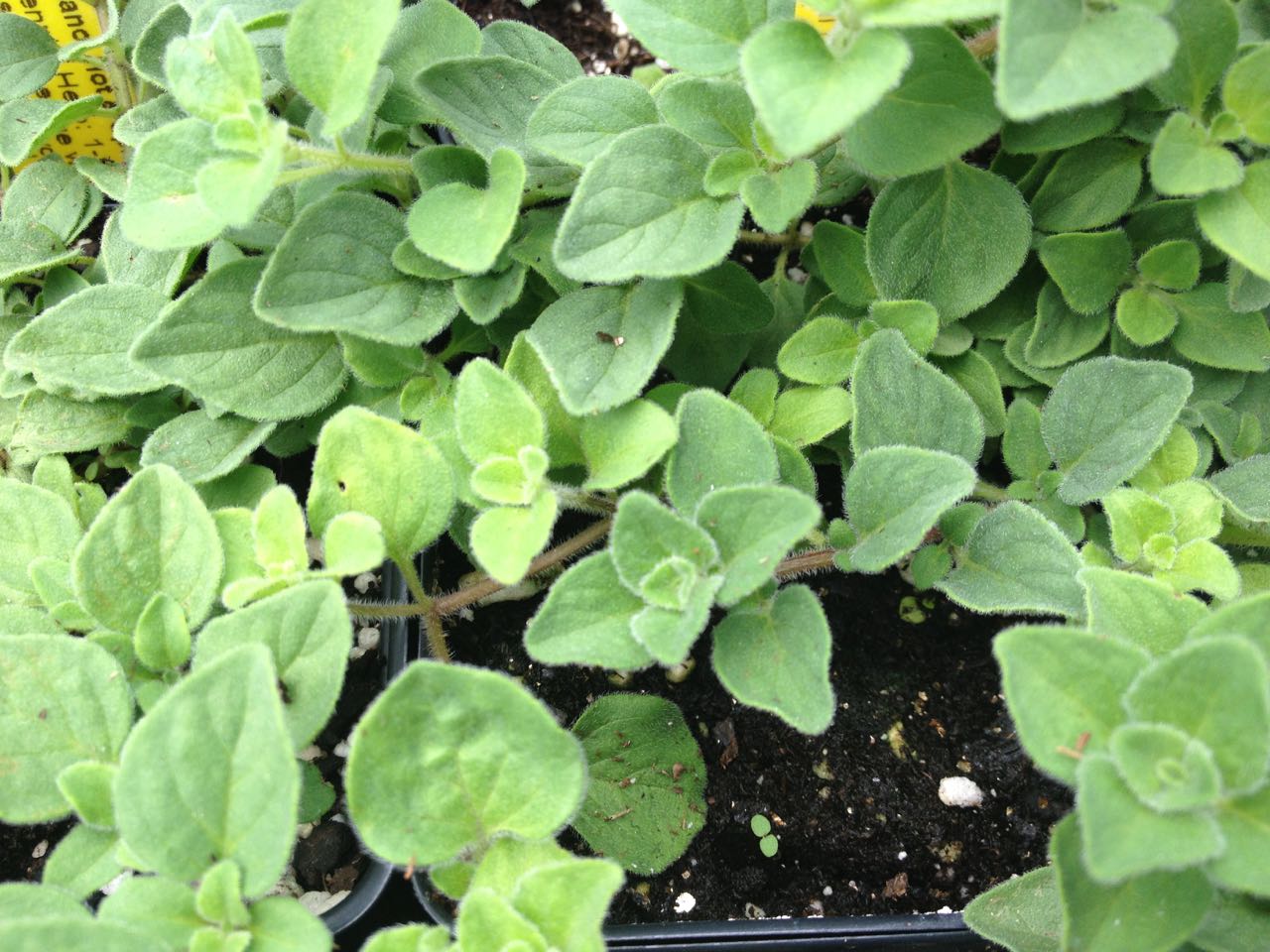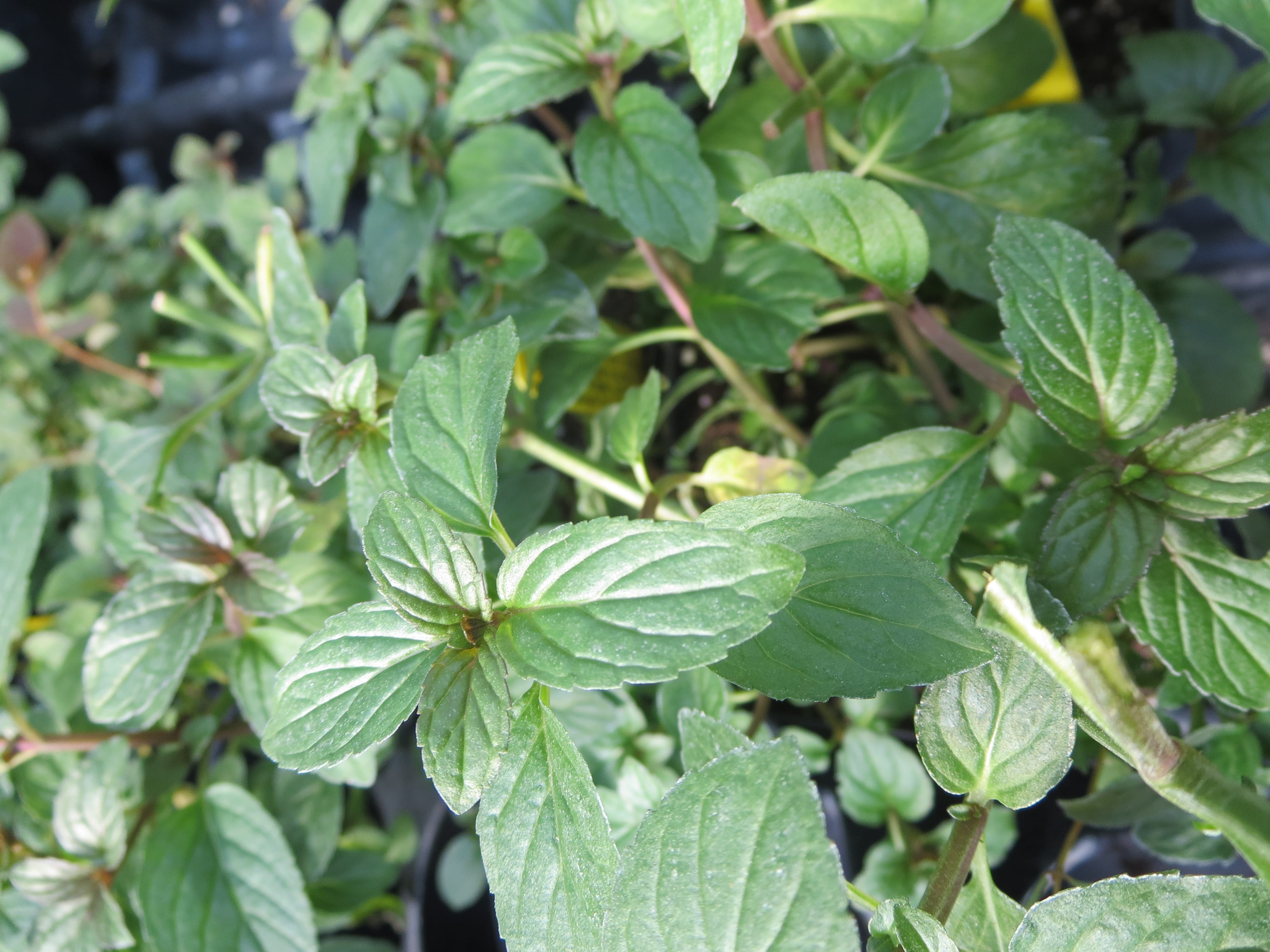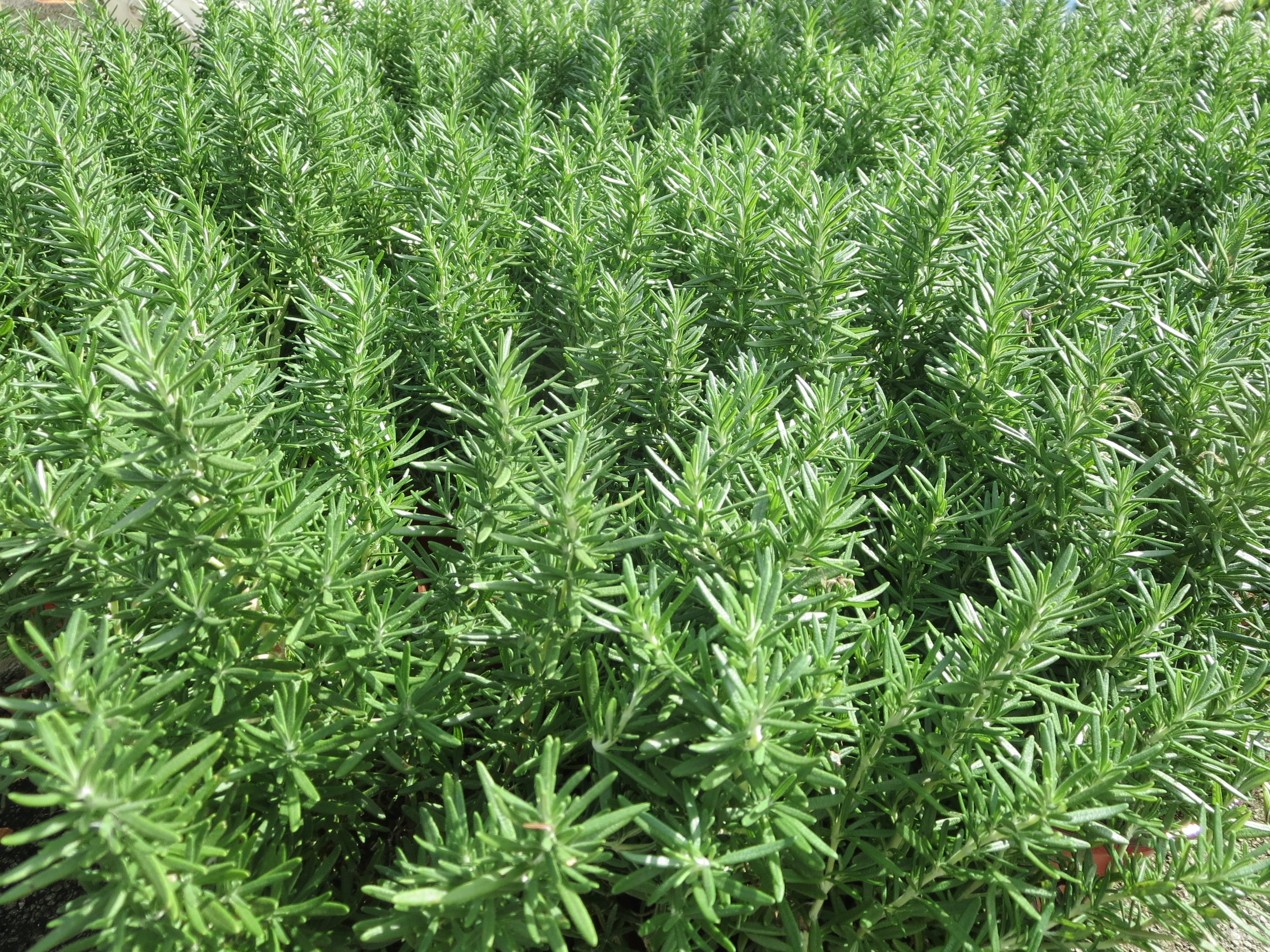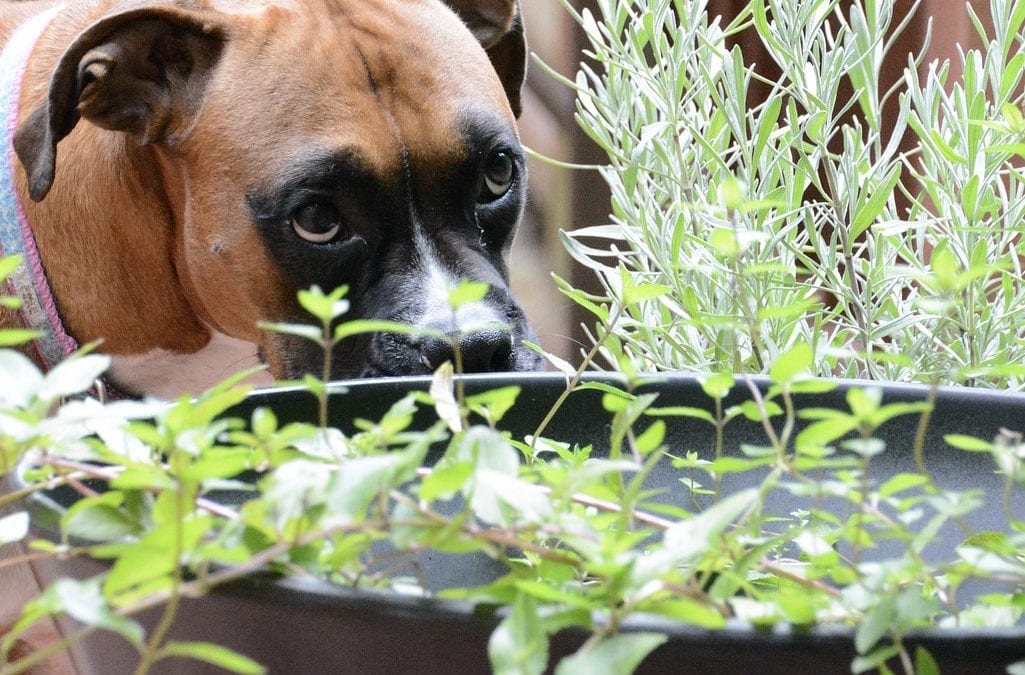We’re howling about the dog-friendly herbs curly-leaf parsley (Petroselinum cripsum), oregano, peppermint and rosemary today. Dog owners who are avid gardeners are always hunting for great, dog-friendly plants to add to their landscapes. Today we’re celebrating four of our favorite herbs that are not only safe if Spike takes a little nibble; they also tote great health benefits for your canine pal too!
*While these plants are not toxic to dogs, Rainbow Gardens cannot guarantee that any specific plant won’t make your dog sick. All dogs are different, and it’s up to your discretion to know your dog, research plants, use in moderation, and seek advise from your veterinarian for your pet’s safety.
4 Favorite Dog-Friendly Herbs: Curly-leaf Parsley, Oregano, Peppermint, and Rosemary
Curly-leaf Parsley
Parsley is a perennial herb that adds flavor and decorative flair to many recipes. It generally grows 12”-18” tall x wide, spacing is 12”-15” apart.
Rainbow Gardens carries both curly and flat leaf parsley. But only the curly-leaf parsley Petroselinum cripsum) is not toxic to dogs.

Care for Parsley
- Parsley prefers full sun to part shade
- Parsley can be planted in the ground and containers (choose a deep pot to accommodate its large taproot).
- Choose a well-draining, loamy, soil that’s rich in nitrogen for best results.
- Water parsley regularly. Allow the soil to dry out between watering then soak the plant thoroughly.
Curly-leaf Parsley Health Benefits for Dogs
- Parsley freshens Spike’s breath with anti-microbial properties, which help to prevent germs and bacteria from taking over your dog’s mouth.
- Parsley has anti-inflammatory properties that can benefit arthritic dogs.
- Antiseptic properties of parsley can be helpful in fighting urinary tract infections, and can also be used as a poultice for bee stings.
Oregano
Oregano is a drought-tolerant, perennial herb that is a staple in Italian and Mediterranean recipes. Oregano generally grows 12”-18” tall x wide, spacing is 12”-15” apart.
(Our selection of oregano varieties is outstanding at Rainbow Gardens. Look for Italian, Siscilian, Greek, Cuban, Variegated, Hot & Spicy and more!)

Care for Oregano
- Oregano prefers full sun.
- Oregano can be planted in the ground or containers. Moderately fertile, well-draining soil is perfect for oregano. (Mulching oregano planted in the ground will help to keep the plant clean, preventing soil from splashing on its leaves.)
- Do not over water oregano; allow soil to dry between watering.
Oregano Health Benefits for Dogs
- Oregano is high in antioxidants providing immune system support
- Oil of oregano contains antifungal properties that inhibit the growth of bacteria (oil is concentrated so use small doses). Oregano oil can be used to clean wounds.
- Oregano is also rich in fiber.
- Teas made from oregano can soothe sore muscles and relieve upset stomachs.
Peppermint
Peppermint is usually grown as an annual (spearmint is hardier) peppermint adds a refreshing flavor to beverages, jellies, and other cuisine, and is a pollinator attractor. Peppermint grows to a height of about 12”-18” and should be spaced at least 24” apart.
(Rainbow doesn’t just do peppermint, we have red-stemmed apple, orange, chocolate, lemon, and more. The choices are plentiful!)

Care for Peppermint
- Peppermint is ideal for planting in containers. (Tip: For in ground planting, you can cut the bottom of a plastic pot and bury it to its rim, then plant the mint in the pot. This way mint stays confined to where you want it in the garden.)
- Peppermint should be planted in rich, well-draining soil, in full to part sun (reprieve from late afternoon sun is appreciated).
- Water peppermint regularly, keeping soil consistently moist but not over watered.
Peppermint Health Benefits for Dogs
- Like parsley, peppermint is helpful in freshening your dog’s breath, hooray!
- It can also be used for treating nausea, flatulence, and motion sickness in dogs.
- Stick to dried mint leaves, adding them to dog recipes, instead of mint oil, which can be too concentrated.
Rosemary
Rosemary is an evergreen, perennial herb that makes a beautiful, drought-tolerant species in your landscape. It’s a great pollinator-attracting herb, and adds delicious flavor to culinary dishes, Rosemary comes in two forms (upright and prostrate) and multiple varieties. Average growth is 3’- 4’ (although some upright varieties can grow taller). Space plants at least 24” apart.

Care for Rosemary
- Rosemary prefers full sun but can tolerate a little shade.
- You can plant this herb both in ground and in containers.
- Rosemary does well in alkaline soil, thrives in our Texas heat and is extremely drought-tolerant once established (well-draining soil is a must).
Rosemary Health Benefits for Dogs
- Rosemary contains antimicrobial properties and can be used for treatment of minor cuts or burns, as well as for infections in the mouth, and urinary and digestive tract.
- Antioxidants in rosemary lend to neutralizing free radicals, which damage cells within the body.
- Rosemary also aids digestion, alleviating flatulence and upset stomachs.
- Properties in rosemary have been cited for their ability to repel insects (fleas, ticks). Many pet owners make their own rinses for their dog’s coat. (Steep 1 TBSP of fresh rosemary in a pint of boiling water for 10 minutes. When it has cooled, use as a final rinse after your pet’s bath.)
Again, your vet is a great resource for knowledge on plants that are non-toxic to pets, as is this link from ASPCA, keeping in mind their message from their website, “The consumption of any plant material may cause vomiting and gastrointestinal upset for dogs and cats.”
While large quantities of any consumed plant material may present with mild GI upset, the plants listed in this blog are not considered to be life-threatening to your pets.
Time to shake a leg and get outta here…
~The Happy Gardener

(You and your vet will know your pet best.)


How much peppermint and or parsley do I give my 11lb Morkie
Hi Therese,
That is a good question for your personal vet. It’s always best to let them advise you on any dosage or quantity questions.
I always give a couple leaves as a treat every day or other day it’s not like every day but I do and it helps with bad breath as well as the other benefits. Also give if I notice that they vomit and it’s not due to being sick. Doggies get into a lot of things and if you know your dog you will know when to give things like this. Also do apple cider vinegar in water bowel keeps the track clean and teeth as well.
How much of each can my 60 lb golden have in a day or week??
Hi Lisa,
Sorry I am not qualified to inform you how much of each herb your dog can have. All Animals have unique digestive systems and that is not in my expertise. I would talk to your vet or contact the ASPCA (where we got the info for non-toxic herbs) for quantities that would be suitable for your precious fur baby.
Thankyou For The Information!
this is so helpful. Thank you so much!
Thanks for reading!
My 5 yo GSD goes crazy for the doggie meatballs I make for him: lean ground beef, shredded sweet potatoes, shredded apples, brown rice, salt and parsley!
That sounds like an awesome treat for your furbaby! Thanks for sharing!
Can I get the exact recipe please?
Hi Jen,
I’m not sure what recipe you are referring to? do you mind explaining a little more?
Veterinarians are not schooled in natural healing nor dietary nutrition. Non of the (at least six) vets that I have asked, have NO IDEA. They only will prescribe pharmaceuticals.
Thank you for your feedback, we do appreciate it. Again, these herbs were not listed as suggestions for dietary nutrition nor for natural healing. They are just herbs that are listed as non-toxic for dogs on the reputable ASPCA site.